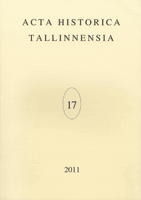EESTI KODANIKE SUNDMIGRATSIOON ITTA AASTAIL 1941–1951: MÕNINGAID VÕRDLUSJOONI LÄÄNDE PÕGENENUTE LOOGA
FORCED MIGRATION OF ESTONIAN CITIZENS TO THE EAST IN 1941–1951: ON DATUM LINES IN THE HISTORY OF REFUGEES TO THE WEST
Author(s): Aigi Rahi-TammSubject(s): History
Published by: Eesti Teaduste Akadeemia Kirjastus
Keywords: Estonia; Estonian History; MIGRATION OF ESTONIAN CITIZENS ; 1941–1951; HISTORY OF REFUGEES TO THE WEST
Summary/Abstract: In September 1944, another seizure of power took place in Estonia. About 80,000 persons decided to set out and flee Estonia. Those who stayed at home were again caught by Soviet punitive policy – arrests, deportations, violence. Instead of restoring homes after WW II, the years ahead brought about uprooting thousands of homes again and driving people away from their native land. Elimination, deracination and assimilation into a new environment of part of the countries’ population were the prerequisite for reorganisation of the social structure of the Baltic States. The course of life of refugees and those sentenced to prison camps and exile has mainly been addressed separately in historical surveys; however, when observing those persons’ lives certain relationships, comparisons and connections can be brought forth. To a great extent, those were stories about broken up families, endured both in the East and the West. Although their course of life was very different, when out of their own country, they had to face a number of similar forced situations and emotions like missing their native land, uncertainty of what was going to happen, hardships of coping with life, scornful attitudes, various restrictions, death, grief, etc. These features reflect more extensive processes characteristic of migration, often, when describing the situations (of both refugees and deportees) similar words and terms are used, at the same time the deeper meaning of their actual situations is not unambiguously transferable from one category to another. What the positions of the “aliens” were going to be like in the receiving country/district, how the “aliens” became integrated into the other society, how they preserved (or lost) their identity, etc. – these are only a few common questions to be asked both refugees and deportees. Undoubtedly this is a broad topic and the article will outline only a range of problems that arise when describing the processes. In the main, the article observes the situations, characteristic of deportation, at the same time touching on specifics related to the Great Flight. There are many factors that shaped the people’s destiny abroad and their meaning is more variegated than we have been able to notice when drawing hasty conclusions. Although the deported persons were all doomed to pain and sufferings, they did not make up any homogeneous mass. The similar truth could also be arrived at in the case of the stories of refugees. All their stories that are based on their background, implication, descriptions of their course of life, coping with life, possibilities as far as individuals, intermediate stages and districts are concerned vary considerably. Based on individual examples, even at the moment of deportation (when deportation was convoyed by armed riflemen) different decisions could be made.
Journal: Acta Historica Tallinnensia
- Issue Year: 2011
- Issue No: 17
- Page Range: 072-094
- Page Count: 23
- Language: Estonian

